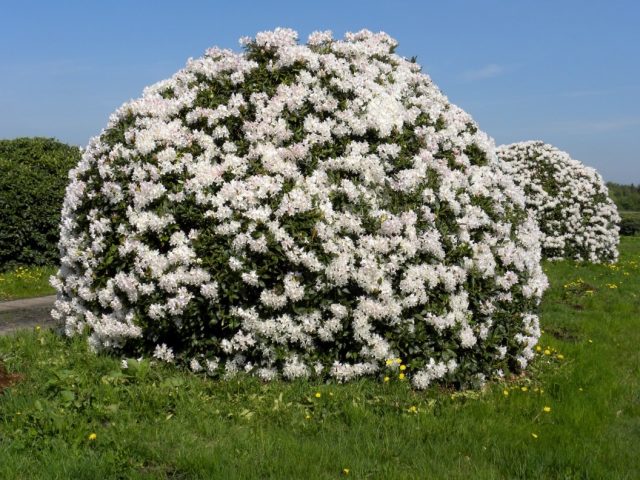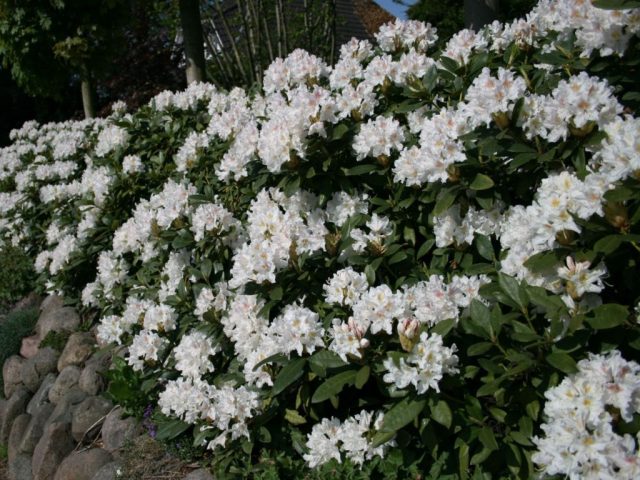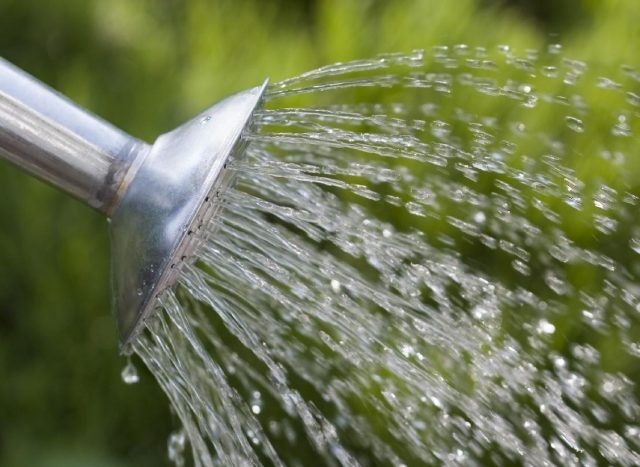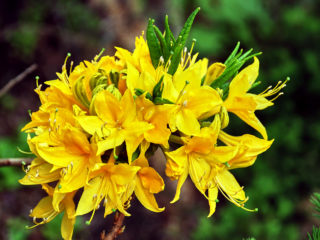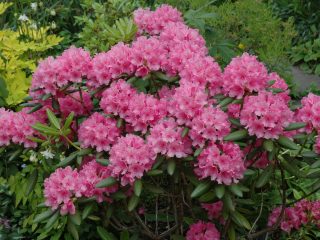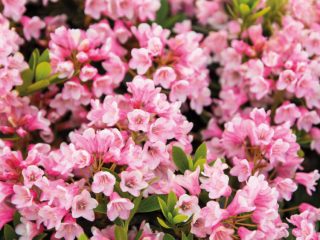Content
- 1 Description of rhododendron Cunninghams White
- 2 Winter hardiness of rhododendron Cunninghams White in the Moscow region
- 3 Growing conditions for hybrid rhododendron Cunninghams White
- 4 Planting and caring for the Cunninghams White rhododendron
- 5 Reproduction
- 6 Diseases and pests
- 7 Conclusion
- 8 Reviews of the rhododendron Cunninghams White
Rhododendron Cunninghams White is a variety obtained in 1850 by breeder D. Cunningham. Belongs to the Caucasian group of rhododendrons. One of the first it was brought to the northern latitudes because of its increased winter hardiness. Suitable for cultivation in private plots, as well as in urban environments, as it is resistant to air pollution.
Description of rhododendron Cunninghams White
Rhododendron Cunninghams White is an evergreen ornamental shrub belonging to the Heather family. The bush grows sprawling, strongly branched. The crown of an adult shrub at 10 years old reaches a height of 2 m, in diameter - 1.5 m.
A photo of the Cunninghams White rhododendron shows that its crown forms a dome shape. Stems are woody. The leaves are dark green, large - about 10-12 cm, elliptical, leathery.
The buds form a light pink color. The flowers are white, with pale purple or brown blotches on the upper petal. 7-8 flowers are formed in the inflorescence. Blooms profusely in April-May. May bloom again in autumn, but this reduces the intensity of spring bloom. There is no aroma.
Winter hardiness of rhododendron Cunninghams White in the Moscow region
Rhododendron Cunninghams White is suitable for cultivation in the Moscow region. The zone of winter hardiness of the shrub is 5, which means that it is possible to withstand frosts down to -28 ... - 30 ° C without shelter. But in severe winters, shoots freeze up.
Growing conditions for hybrid rhododendron Cunninghams White
Rhododendron Cunninghams White is less picky about soil acidity than other varieties of the crop. The shrub can be planted singly or in groups. The distance between individual plants is from 1 to 2 m, depending on the size of the crops. The soil under the rhododendron must be mulched.
The root system of the shrub is shallow, so it is not recommended to plant it next to larger trees with a similar root system, for example, birch, oak, willow. Dominant plants will take most of the nutrients from the soil. Most favorably, the Cunninghams White rhododendron is adjacent to areas with pines, spruces, junipers.
Planting and caring for the Cunninghams White rhododendron
Planting the Cunninghams White rhododendron in a permanent place is possible in the spring, but before the plant awakens, and also in the fall. Seedlings with a closed root system are transplanted throughout the summer. The shrub is good for transplanting at any age. Young plants can be dug up, placed in large containers and brought indoors for the winter.
Selection and preparation of the landing site
The root system of the Cunninghams White rhododendron is fibrous. For the development of a plant, it must be grown in loose, well-drained soil with an acidic reaction, so that the thin roots can freely absorb moisture and nutrients.
The landing site should be protected from the winds, in partial shade. In full sun, the plant will fade and dry out.The best place to plant is the northeast side or wall of the building.
Seedling preparation
Before planting, the root system of the Cunninghams White rhododendron, along with the earthy clod, is removed from the container and inspected. Roots that have been in contact with the container for a long time die off and create a felt layer through which it is difficult for young roots inside the coma to break through. Therefore, before planting, dead roots must be removed or a lump cut in several places.
To soften the root system, the earthen lump is released into water so that it is saturated with moisture. Leave for a while until air bubbles stop rising to the surface. Before planting, the roots are straightened, if possible, but the earthen lump is not completely destroyed.
Landing rules
For planting, a large pit is prepared, 2-3 times larger than the earthen coma in which the seedling grew. The soil removed from the pit is combined with an acidic substrate, in a 1: 1 ratio. Such a substrate can consist of pine forest litter, high-moor red peat.
A complex mineral fertilizer or specialized fertilizer for rhododendrons is introduced into the soil to fill the pit. The seedling is released vertically, without deepening.
When planting a shrub, the root collar should remain 2 cm above the general soil level. Otherwise, the plant may become unviable. The earth around the planting is slightly compacted and watered from above along the crown. After planting, the trunk circle must be mulched with pine bark. Mulch without touching the root collar, so as not to provoke fungal infections. In hot weather, after planting, the plant is shaded.
A layer of mulch is poured several times per season. The soil under the bush is not loosened or dug up so as not to touch the root system close to the soil surface.
Watering and feeding
When growing rhododendron Cunninghams White, regular watering is necessary, the soil does not dry out. The shrub is responsive to sprinkling with small drops. Tap water is not used for irrigation.
Under the rhododendrons, the acidic reaction of the soil is maintained. To do this, once a month it is watered with dilute citric acid or special solutions for rhododendrons.
Depending on the initial soil fertility, Cunninghams White rhododendron is fed 3 times per growing season:
- Before flowering. Fast-dissolving fertilizers are used for rhododendrons with the addition of nitrogen in an increased volume. Also use "Azofoska" or "Kemiru wagon".
- After flowering. Superphosphate is used in the amount of 30 g and 15 g of potassium sulfate with a small amount of complex fertilizers.
- At the end of summer, the plant is prepared for winter and nitrogen-free fertilizers are used.
When using dry fertilizers, they are introduced into the soil along the diameter of the bush, liquid fertilizers are poured into the center.
Pruning
The crown of the Cunninghams White rhododendron grows slowly, so formative pruning is not required for the shrub. In the spring and during the growing season, sanitary inspections are carried out and broken or dead branches are removed.
To lay leaf buds, as well as flower buds for the next year, wilted inflorescences are carefully twisted and removed. It is impossible to cut and cut them off because of the close occurrence of the kidneys and the possibility of their damage.
Preparing for winter
For successful wintering, the soil under the rhododendron is watered abundantly in the period before the onset of frost. In the early years of planting, the Cunninghams White rhododendron is covered with spruce branches, dry air shelters are built. To do this, a burlap or other covering material of a light color is pulled over the frame.
It is difficult to cover adults, overgrown bushes.Therefore, they only protect the root system, hilling it with the use of high-moor peat. In winter, snow is thrown over the shrubbery, but the snow is shaken off the remaining shoots and leaves so that they do not break under its weight.
Reproduction
Rhododendron Cunninghams White is propagated vegetatively using cuttings and seeds. Cuttings are taken from an adult bush after the flowering period. For reproduction, cuttings 6-8 cm long are used, a few leaves are left at the top, the rest are removed.
The cuttings take root for a long time, so they are preliminarily kept for 15 hours in root formation stimulants. Then they are germinated in a planting container with wet sandy-peat soil. Rooting takes 3-4 months.
Diseases and pests
Rhododendron Cunninghams White has no specific diseases and pests. When properly planted and cared for, it is rarely infested.
Rhododendron can be susceptible to leaf chlorosis, fungal diseases. For prevention in early spring, the bush is sprayed with copper-containing preparations. The solutions are applied by spraying to the top and bottom of the leaves and to the soil around the bush.
Various leaf-gnawing and other parasitic insects are eliminated by spraying with insecticides. Acaricides are used against spider mites.
Conclusion
Rhododendron Cunninghams White is one of the oldest and time-tested varieties. Resistant to cold winters. Subject to simple agricultural techniques, it becomes a flowering long-lived shrub to decorate the garden.
